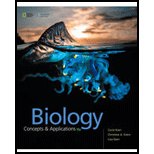
Concept explainers
Most commonly, individuals of a natural population show a __________ distribution through their habitat.
| a. random | b. clumped | c. near uniform |
Introduction:
Ecology is the term which is used to study the interactions among organisms and their living and nonliving environment. Demographics are statistical characteristics that are used by ecologists to describe a population.
Answer to Problem 1SA
Correct answer:
Most commonly, individuals of a natural population show a clumped distribution through their habitat. Hence, the correct answer is option b.
Explanation of Solution
Reason for correct answer:
Option b. is given as “clumped”.
Population distribution is the term which is used to describe the location of individuals relative to one another. A patchy distribution of resources is responsible for the most common population distribution pattern to be clumped one.
Reason for incorrect answer:
Option a. is given as, “random”.
Population distribution pattern can be clumped, random or near uniform but, patchy distribution of resources favor the clumped population distribution pattern. Hence, option a. is incorrect.
Option c. is given as, “near uniform”.
Intense competition for limited resources may favor the near uniform population distribution pattern but commonly the members of a population are clumped together. Hence, option c. is incorrect.
Hence, the options a. and c. are incorrect.
Commonly, the members of a population show a clumped distribution pattern through their habitat. Thus, the correct option is b.
Want to see more full solutions like this?
Chapter 40 Solutions
BIOLOGY:CONCEPTS+APPL.(LOOSELEAF)
- Briefly state the physical meaning of the electrocapillary equation (Lippman equation).arrow_forwardExplain in a small summary how: What genetic information can be obtained from a Punnet square? What genetic information cannot be determined from a Punnet square? Why might a Punnet Square be beneficial to understanding genetics/inheritance?arrow_forwardIn a small summary write down:arrow_forward
- Not part of a graded assignment, from a past midtermarrow_forwardNoggin mutation: The mouse, one of the phenotypic consequences of Noggin mutationis mispatterning of the spinal cord, in the posterior region of the mouse embryo, suchthat in the hindlimb region the more ventral fates are lost, and the dorsal Pax3 domain isexpanded. (this experiment is not in the lectures).a. Hypothesis for why: What would be your hypothesis for why the ventral fatesare lost and dorsal fates expanded? Include in your answer the words notochord,BMP, SHH and either (or both of) surface ectoderm or lateral plate mesodermarrow_forwardNot part of a graded assignment, from a past midtermarrow_forward

 Biology (MindTap Course List)BiologyISBN:9781337392938Author:Eldra Solomon, Charles Martin, Diana W. Martin, Linda R. BergPublisher:Cengage Learning
Biology (MindTap Course List)BiologyISBN:9781337392938Author:Eldra Solomon, Charles Martin, Diana W. Martin, Linda R. BergPublisher:Cengage Learning Biology Today and Tomorrow without Physiology (Mi...BiologyISBN:9781305117396Author:Cecie Starr, Christine Evers, Lisa StarrPublisher:Cengage Learning
Biology Today and Tomorrow without Physiology (Mi...BiologyISBN:9781305117396Author:Cecie Starr, Christine Evers, Lisa StarrPublisher:Cengage Learning Concepts of BiologyBiologyISBN:9781938168116Author:Samantha Fowler, Rebecca Roush, James WisePublisher:OpenStax College
Concepts of BiologyBiologyISBN:9781938168116Author:Samantha Fowler, Rebecca Roush, James WisePublisher:OpenStax College





